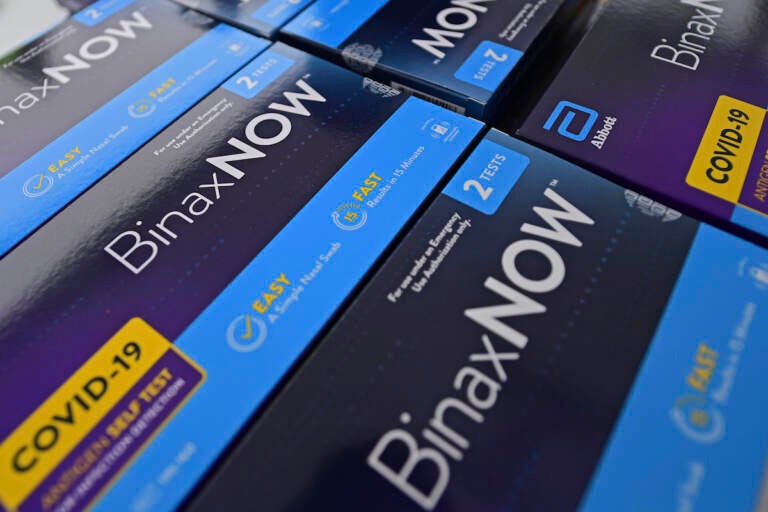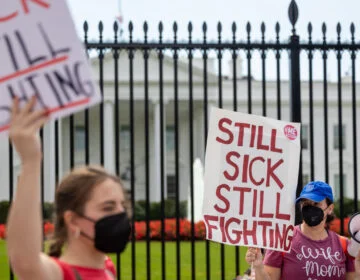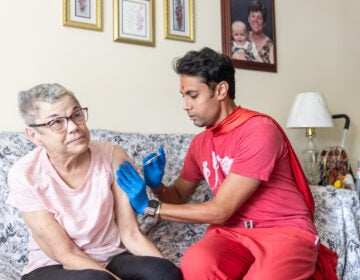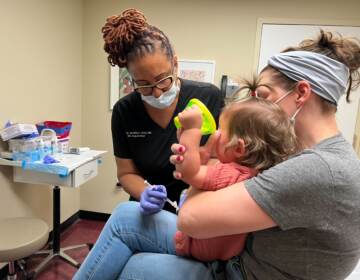I tested positive for COVID on a home test. How do I report it?
The quality of the test depends on the person using it, experts say. Yet some counties find the information useful for seeing the bigger picture.
Listen 3:31
At-home COVID-19 tests kits sit on a table before being handed out at a distribution site, Thursday, Dec. 30, 2021, in Youngstown, Ohio. (AP Photo/David Dermer)
Ask us about COVID-19: What questions do you have about the coronavirus and vaccines?
This is one of a series of articles in which reporters from WHYY’s Health Desk Help Desk answer questions about vaccines and COVID-19 submitted by you, our audience.
More than a week ago, Ellen Shapiro’s husband found out he had been exposed to someone who tested positive for COVID-19. Her family had some rapid antigen tests at home, and her husband tested positive.
Both they and their son have been vaccinated and have been at home isolating ever since. Her husband has had only mild symptoms.
Shapiro would like to report the positive COVID-19 test to the Health Department in Philadelphia, where she lives, but she doesn’t know how to do it.
“Everybody’s using the rapid tests; those don’t get reported. And so I think there’s a real skewed image of what the numbers in the state really are,” she said. “I think businesses and families are making decisions based on those numbers, not knowing how many people are really positive at this point.”
That raises a larger issue, and health departments around the country have reached different conclusions: Should they collect data from the people testing positive for COVID-19 at home?
Philadelphia is not doing that, said James Garrow, communications director for the city’s Department of Public Health. There are two reasons, he said: First, it would take quite a bit of effort for the city to set up a secure way to convey what could be private health information that requires layers of security.
But more importantly, he said, at this point the Health Department knows the reported number of COVID-19 cases underestimates the real number, and it doesn’t change the department’s decisions to know that the real number is, say, 3,100 instead of 3,000.
“Our goal is probably going to focus on how hospitalizations are doing and not overall counts, beyond just the rough case counts that we see as a result of lab testing,” Garrow said. “That’ll give us a good view of how the disease is spreading in the city; it’ll tip us off when we see a spike.”
Michael LeVasseur, assistant teaching professor of epidemiology and biostatistics at Drexel University, said this approach makes sense. He said the case numbers have always been interesting, but one problem is that they do not measure the same thing over time. The case numbers change depending on who has access to testing, and how quickly health departments can collect and report those results.
“People are more likely to get tested around the holidays, or identify more cases over the holidays. It’s also true that when there are waves of infection, people might be more symptomatic — you’ve got to look at it through the lens of who is getting tested, why are they getting tested, what’s happening,” he said. “With data on hospitalizations and data on deaths, those are much stronger signals about what is going on on the ground.”
No one metric is going to lead to a complete picture of what is going on with COVID-19, LeVasseur pointed out, because each number measures something different. However, one way to get around the problem with measuring cases is to look at testing numbers from hospitals and clinics, a model called sentinel surveillance that is used to track diseases like the flu.
Aimee Palumbo, an epidemiologist and assistant professor of instruction and graduate program director at Temple University, agreed, but added that for that kind of system, it would be best to have a good idea of how many cases lead to people going to the hospital.
“With each variant, and with each wave, it seems to be slightly different, we need … to get that initial estimate … of the true burden of cases in a population and then the associated hospitalizations,” Palumbo said.
Some health departments in the region take a different approach than Philadelphia.
For example, Montgomery County has set up a webpage for residents to report positive home COVID-19 test results. Michel Masters, division director of communicable disease control, said the county set up this system in the last week of December both to collect data about how many people report positive home test results, but also to directly address those people about how to interpret test results and isolate at home. As of Jan. 3, more than 270 people had used the system to report their test results, both positive and negative.
Last August, after it launched a brief program through which public libraries gave out test kits, Delaware started asking people who test positive at home to contact the state. Delaware Medical Director Rick Hong said they don’t include those results in the case count, because the quality of the test depends on the person using it.
Camden County Health Officer Paschal Nwako would like people who test positive to call and leave a message, so his team can call back and ask for more information and verification, which they can upload to the state’s system for tracking communicable diseases.
It’s helpful for health departments to get information from home COVID-19 tests, to have an idea of how many more positive cases are out in the community, said Stephanie Silvera, epidemiologist and professor of public health at Montclair State University. She said some of those individuals will end up in a hospital, so it is good to be able to anticipate how many people may be coming.
However, she also said local public health departments have limited resources to collect data, which in itself is a problem.
“It’s unfortunate that there has to be a trade-off in understanding the demographics and the true prevalence of the disease in different communities, versus being able to address the really acute pressing needs of hospitalizations.”

Saturdays just got more interesting.
WHYY is your source for fact-based, in-depth journalism and information. As a nonprofit organization, we rely on financial support from readers like you. Please give today.





![CoronavirusPandemic_1024x512[1]](https://whyy.org/wp-content/uploads/2020/03/CoronavirusPandemic_1024x5121-300x150.jpg)


